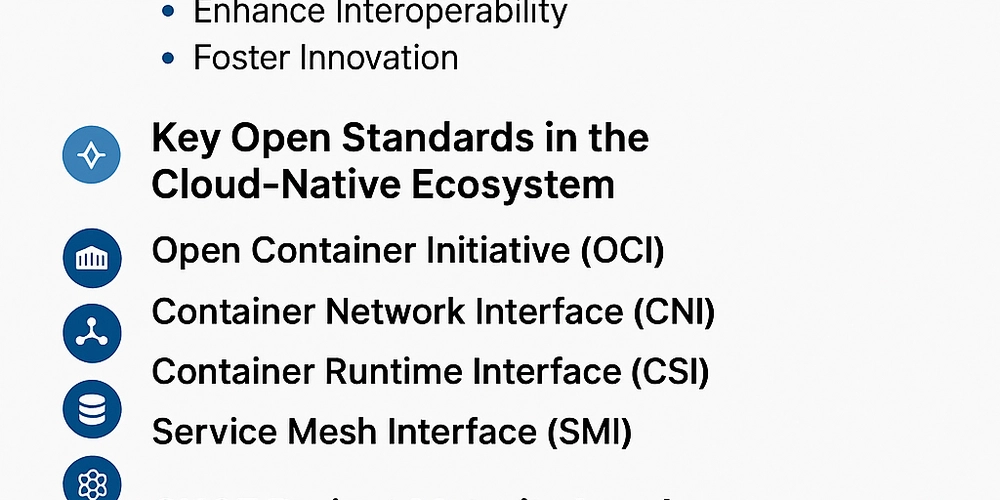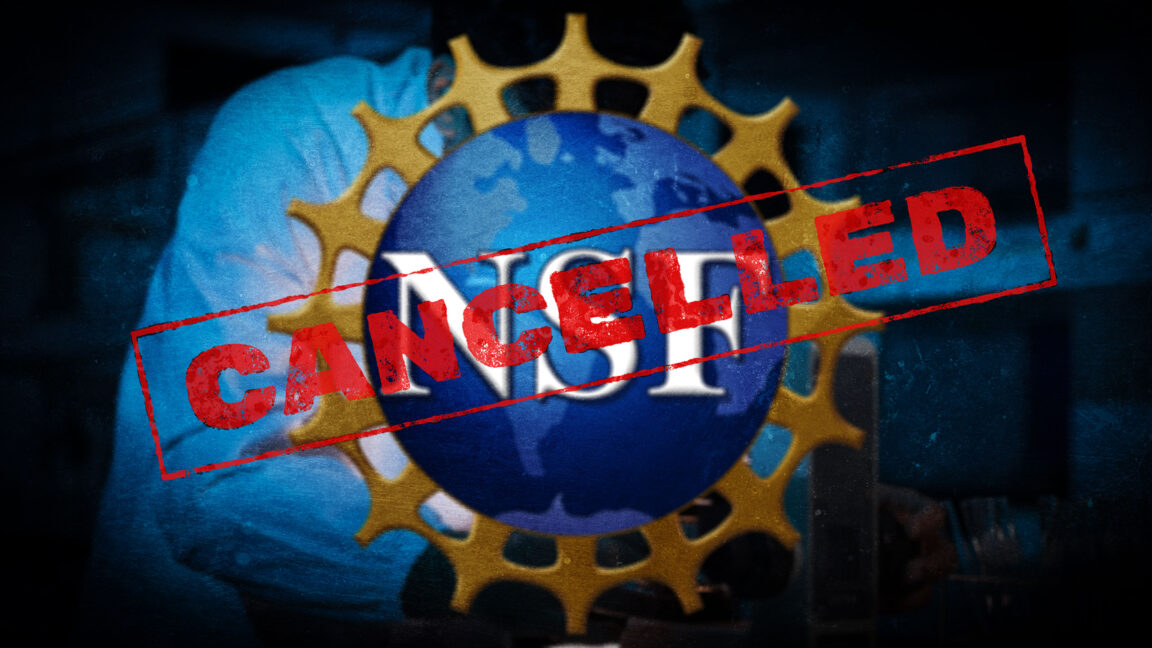Embracing Open Standards in Cloud-Native Development
Table of Contents Why Open Standards Matter Key Open Standards in the Cloud-Native Ecosystem Open Container Initiative (OCI) Container Network Interface (CNI) Container Runtime Interface (CRI) Container Storage Interface (CSI) Service Mesh Interface (SMI) CNCF Project Maturity Levels Sandbox Stage Incubating Stage Graduation Stage Conclusion Description In the rapidly evolving landscape of cloud-native technologies, open standards play a pivotal role in ensuring interoperability, scalability, and innovation. By adhering to open specifications, developers and organizations can avoid vendor lock-in, foster collaboration, and build robust systems that stand the test of time. Why Open Standards Matter Open standards are the backbone of a healthy and collaborative cloud-native ecosystem. They provide a common language and set of expectations that enable diverse tools and platforms to work together seamlessly. By embracing open standards, developers can: Avoid Vendor Lock-In: Easily switch between providers without significant rework. Enhance Interoperability: Ensure different components of the system can communicate effectively. Foster Innovation: Encourage community contributions and rapid development. Key Open Standards in the Cloud-Native Ecosystem Open Container Initiative (OCI) The Open Container Initiative (OCI) defines standards for container formats and runtimes to ensure consistency and compatibility across different container tools and platforms. It encompasses: Image Specification: Defines how to build and package container images. Runtime Specification: Specifies the configuration and lifecycle of containers. Distribution Specification: Standardizes the distribution of container images. Container Network Interface (CNI) The Container Network Interface (CNI) provides a standardized way to configure network interfaces in Linux containers. It defines: A format for network configuration. A protocol for container runtimes to make network requests. Procedures for executing and delegating plugins. (A brief overview of the Container Network Interface (CNI ... - Red Hat, cni/SPEC.md at main · containernetworking/cni - GitHub) This ensures that containers can communicate over the network reliably. Container Runtime Interface (CRI) The Container Runtime Interface (CRI) is a plugin interface that allows Kubernetes to use various container runtimes without the need to recompile cluster components. It enables: (A standard interface for service meshes on Kubernetes - SMI Flexibility in choosing container runtimes. Simplified integration of new runtimes into Kubernetes. This abstraction layer enhances the modularity and extensibility of Kubernetes. Container Storage Interface (CSI) The Container Storage Interface (CSI) standardizes the way storage systems are exposed to containerized workloads. It allows: Third-party storage providers to develop plugins. Kubernetes and other orchestration systems to integrate storage solutions seamlessly. (Graduated and Incubating Projects | CNCF) This promotes a diverse and flexible storage ecosystem. Service Mesh Interface (SMI) The Service Mesh Interface (SMI) provides a standard interface for service meshes on Kubernetes, focusing on: Traffic policy management. Telemetry and observability. Secure service-to-service communication. By offering a common set of APIs, SMI enables interoperability among different service mesh implementations. CNCF Project Maturity Levels The Cloud Native Computing Foundation (CNCF) categorizes projects based on their maturity to guide adoption and development: Sandbox Stage This is the entry point for early-stage projects. Sandbox projects are experimental and are meant to foster innovation and community collaboration. Incubating Stage Projects in this stage have demonstrated growing adoption and have met certain criteria, including: Successful use in production by multiple organizations. A healthy number of contributors and committers. Clear documentation and versioning. Graduation Stage Graduated projects are considered stable and have: Achieved widespread adoption. A robust governance and committer process. Completed a security audit with addressed vulnerabilities. These stages help users assess the readiness and reliability of CNCF projects. Conclusion Open standards are essential for building a resilient and interoperable cloud-native ecosystem. By adhering to specifications like OCI, CNI, CRI, CSI, and SMI, developers can create flexible and scalable applications. Understanding the CNCF project maturity levels further aids in making informed decisions about adopting and contributing to these projects. Embracing open standards not only fosters innovation but also ensures that the cloud-native landscape remains collaborative and vendor-neutr

Table of Contents
- Why Open Standards Matter
-
Key Open Standards in the Cloud-Native Ecosystem
- Open Container Initiative (OCI)
- Container Network Interface (CNI)
- Container Runtime Interface (CRI)
- Container Storage Interface (CSI)
- Service Mesh Interface (SMI)
-
CNCF Project Maturity Levels
- Sandbox Stage
- Incubating Stage
- Graduation Stage
- Conclusion
Description
In the rapidly evolving landscape of cloud-native technologies, open standards play a pivotal role in ensuring interoperability, scalability, and innovation. By adhering to open specifications, developers and organizations can avoid vendor lock-in, foster collaboration, and build robust systems that stand the test of time.
Why Open Standards Matter
Open standards are the backbone of a healthy and collaborative cloud-native ecosystem. They provide a common language and set of expectations that enable diverse tools and platforms to work together seamlessly. By embracing open standards, developers can:
- Avoid Vendor Lock-In: Easily switch between providers without significant rework.
- Enhance Interoperability: Ensure different components of the system can communicate effectively.
- Foster Innovation: Encourage community contributions and rapid development.
Key Open Standards in the Cloud-Native Ecosystem
Open Container Initiative (OCI)
The Open Container Initiative (OCI) defines standards for container formats and runtimes to ensure consistency and compatibility across different container tools and platforms. It encompasses:
- Image Specification: Defines how to build and package container images.
- Runtime Specification: Specifies the configuration and lifecycle of containers.
- Distribution Specification: Standardizes the distribution of container images.
Container Network Interface (CNI)
The Container Network Interface (CNI) provides a standardized way to configure network interfaces in Linux containers. It defines:
- A format for network configuration.
- A protocol for container runtimes to make network requests.
- Procedures for executing and delegating plugins. (A brief overview of the Container Network Interface (CNI ... - Red Hat, cni/SPEC.md at main · containernetworking/cni - GitHub) This ensures that containers can communicate over the network reliably.
Container Runtime Interface (CRI)
The Container Runtime Interface (CRI) is a plugin interface that allows Kubernetes to use various container runtimes without the need to recompile cluster components. It enables: (A standard interface for service meshes on Kubernetes - SMI
- Flexibility in choosing container runtimes.
- Simplified integration of new runtimes into Kubernetes. This abstraction layer enhances the modularity and extensibility of Kubernetes.
Container Storage Interface (CSI)
The Container Storage Interface (CSI) standardizes the way storage systems are exposed to containerized workloads. It allows:
- Third-party storage providers to develop plugins.
- Kubernetes and other orchestration systems to integrate storage solutions seamlessly. (Graduated and Incubating Projects | CNCF) This promotes a diverse and flexible storage ecosystem.
Service Mesh Interface (SMI)
The Service Mesh Interface (SMI) provides a standard interface for service meshes on Kubernetes, focusing on:
- Traffic policy management.
- Telemetry and observability.
- Secure service-to-service communication.
By offering a common set of APIs, SMI enables interoperability among different service mesh implementations.
CNCF Project Maturity Levels
The Cloud Native Computing Foundation (CNCF) categorizes projects based on their maturity to guide adoption and development:
Sandbox Stage
This is the entry point for early-stage projects. Sandbox projects are experimental and are meant to foster innovation and community collaboration.
Incubating Stage
Projects in this stage have demonstrated growing adoption and have met certain criteria, including:
- Successful use in production by multiple organizations.
- A healthy number of contributors and committers.
- Clear documentation and versioning.
Graduation Stage
Graduated projects are considered stable and have:
- Achieved widespread adoption.
- A robust governance and committer process.
- Completed a security audit with addressed vulnerabilities. These stages help users assess the readiness and reliability of CNCF projects.
Conclusion
Open standards are essential for building a resilient and interoperable cloud-native ecosystem. By adhering to specifications like OCI, CNI, CRI, CSI, and SMI, developers can create flexible and scalable applications. Understanding the CNCF project maturity levels further aids in making informed decisions about adopting and contributing to these projects.
Embracing open standards not only fosters innovation but also ensures that the cloud-native landscape remains collaborative and vendor-neutral.







































































































































































![[The AI Show Episode 145]: OpenAI Releases o3 and o4-mini, AI Is Causing “Quiet Layoffs,” Executive Order on Youth AI Education & GPT-4o’s Controversial Update](https://www.marketingaiinstitute.com/hubfs/ep%20145%20cover.png)
































































































































![From Art School Drop-out to Microsoft Engineer with Shashi Lo [Podcast #170]](https://cdn.hashnode.com/res/hashnode/image/upload/v1746203291209/439bf16b-c820-4fe8-b69e-94d80533b2df.png?#)










































































































(1).jpg?#)





























_Inge_Johnsson-Alamy.jpg?width=1280&auto=webp&quality=80&disable=upscale#)













































































































![Apple Developing AI 'Vibe-Coding' Assistant for Xcode With Anthropic [Report]](https://www.iclarified.com/images/news/97200/97200/97200-640.jpg)
![Apple's New Ads Spotlight Apple Watch for Kids [Video]](https://www.iclarified.com/images/news/97197/97197/97197-640.jpg)









































































![[Weekly funding roundup April 26-May 2] VC inflow continues to remain downcast](https://images.yourstory.com/cs/2/220356402d6d11e9aa979329348d4c3e/WeeklyFundingRoundupNewLogo1-1739546168054.jpg)




























